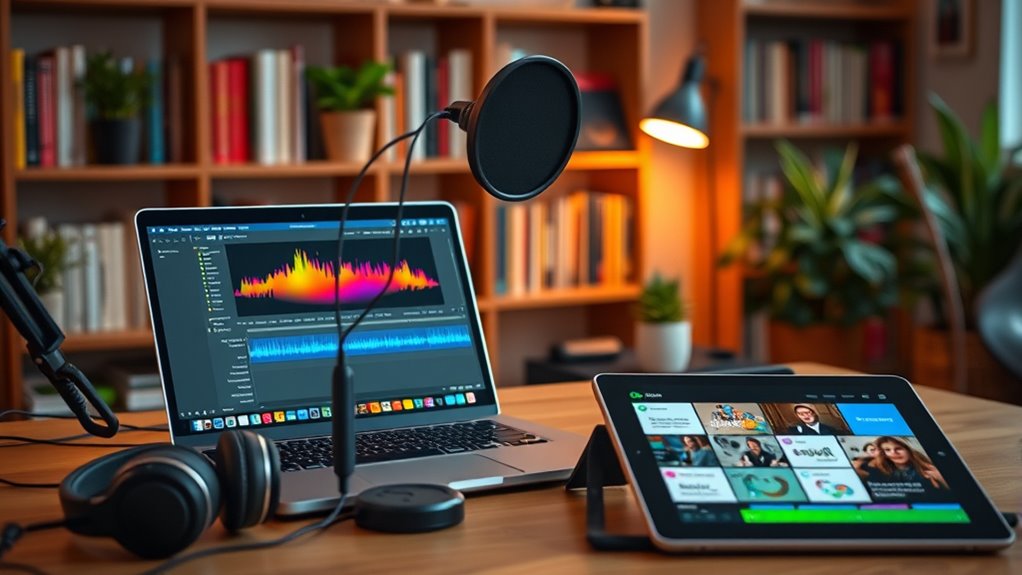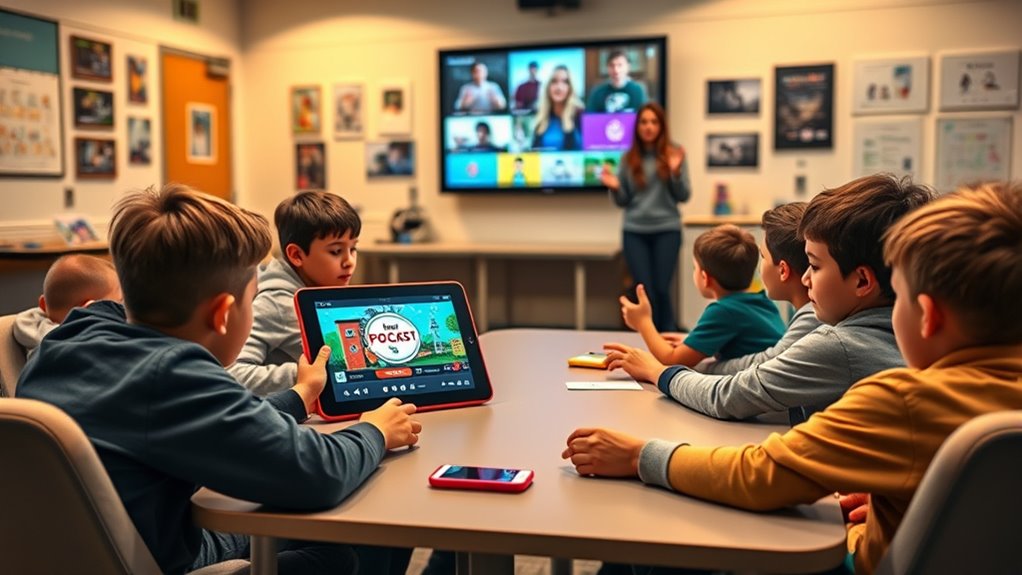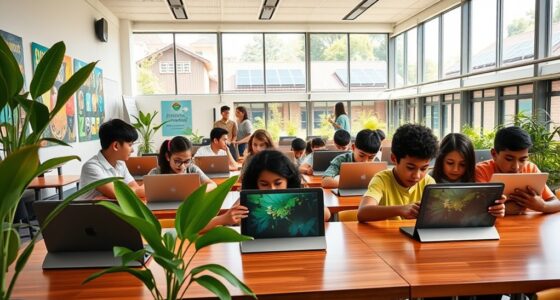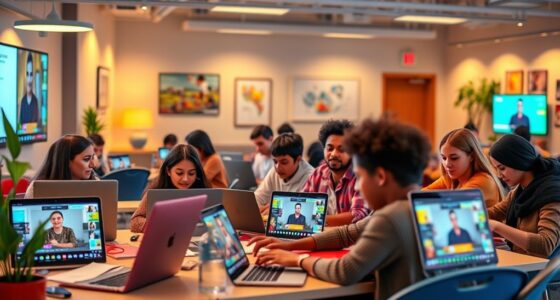Using podcasts and multimedia media transforms learning into an engaging, interactive experience that keeps you interested and motivated. They offer versatile ways to present content, blending storytelling, images, sound effects, and videos to make lessons memorable. These tools cater to different learning styles, ensuring everyone stays involved. Plus, they’re accessible anytime, making learning flexible. Keep exploring to discover how to harness these powerful approaches and make your educational journey more dynamic.
Key Takeaways
- Podcasts and multimedia tools transform passive learning into immersive, interactive experiences that boost engagement and retention.
- Integrating multimedia elements like images, sound effects, and videos enhances storytelling and appeals to diverse learning styles.
- Interactive storytelling encourages critical thinking, decision-making, and active participation throughout the learning process.
- Digital media offers flexible, accessible content that can be easily updated and tailored to current educational needs.
- Combining edutainment with credible sources and interactive components fosters curiosity, trust, and deeper understanding among learners.

In today’s digital age, podcasts and multimedia media have become powerful tools for creating engaging learning experiences. They offer a versatile platform to deliver content in ways that captivate learners and foster active participation. One key approach is through interactive storytelling, which transforms passive listening into an immersive journey. Instead of simply presenting facts, you can craft narratives that involve the learner, making the experience more memorable and emotionally resonant. By integrating multimedia elements such as images, sound effects, and videos alongside audio narratives, you deepen engagement and cater to various learning styles. This multimedia integration helps break down complex concepts into digestible, visually appealing segments, making learning both enjoyable and effective.
When you incorporate interactive storytelling in your educational content, you’re encouraging learners to think critically and choose their paths within the narrative. This method invites them to become active participants rather than passive listeners, which boosts retention and comprehension. For instance, a podcast about historical events might include pauses where learners are prompted to reflect or make decisions that influence the story’s progression. Adding multimedia components like relevant visuals or audio clips at these junctures enriches the experience, making it more tangible. The combination of storytelling and multimedia integration transforms traditional lessons into engaging adventures, motivating learners to stay attentive and involved.
Furthermore, multimedia integration allows you to address different learning preferences. Visual learners benefit from images and videos, auditory learners from well-crafted narration and sound effects, and kinesthetic learners can engage with supplementary activities linked to the multimedia content. This multisensory approach guarantees that your educational material appeals to a broader audience, enhancing understanding and retention. You can also leverage interactive elements such as quizzes or prompts embedded within multimedia presentations, encouraging learners to apply what they’ve heard and seen in real-time.
Using podcasts and multimedia media to facilitate interactive storytelling not only makes learning more engaging but also more accessible. Learners can access content whenever and wherever they want, fitting education into their busy lives. The flexibility of multimedia integration means you can update content easily, incorporate current events, or tailor stories to specific audiences. Additionally, integrating reliable content sources ensures the accuracy and credibility of your educational material, boosting learner trust and confidence. By blending compelling storytelling with rich multimedia elements, you create dynamic educational experiences that inspire curiosity, promote active learning, and foster long-lasting understanding. This approach transforms traditional education into an interactive adventure, making learning an exciting, personal journey for every learner.
Frequently Asked Questions
How Can Edutainment Be Tailored for Different Age Groups?
You can tailor edutainment for different age groups by creating age-appropriate content that resonates with their interests and comprehension levels. Use interactive methods like quizzes, visual aids, or storytelling to keep them engaged. For younger audiences, simplify concepts and include playful elements. For older learners, incorporate more detailed information and challenge them with problem-solving activities, ensuring the media remains both educational and entertaining for every age.
What Are the Best Platforms for Educational Podcasts?
Imagine a treasure chest filled with gems—each platform offers unique riches. Spotify and Apple Podcasts are your versatile treasure maps, perfect for exploring diverse topics with interactive quizzes and visual storytelling. For visual learners, YouTube and Edutopia’s channels bring concepts alive through engaging videos. These platforms empower you to immerse yourself in educational content that’s interactive, visually appealing, and tailored to your learning style, making education an exciting adventure.
How Do Media Formats Impact Learner Retention?
Media formats considerably impact your learner retention by enhancing visual retention and promoting cognitive engagement. When content uses engaging visuals, videos, or interactive elements, you’re more likely to remember information because your brain processes visuals better than text alone. Interactive media keeps you actively involved, deepening understanding and making learning more memorable. Choosing diverse formats helps you stay engaged and retain information longer, making your learning experience more effective and enjoyable.
Can Edutainment Replace Traditional Classroom Teaching?
Edutainment can’t fully replace traditional classroom teaching, but it greatly enhances learning. You can use interactive quizzes and gamified lessons to engage students actively, making lessons more memorable. These media formats foster motivation and curiosity, complementing classroom instruction. While they’re effective tools, they work best alongside face-to-face teaching, providing diverse ways to meet different learning styles and ensuring a well-rounded education experience.
How Is the Effectiveness of Educational Media Measured?
Have you ever wondered how you know if educational media truly works? You measure its effectiveness through learner engagement and assessment metrics. Tracking how actively learners participate and their understanding through tests or quizzes helps determine impact. Isn’t it essential to see real progress? By analyzing these indicators, you can evaluate whether media enhances learning outcomes, making it a valuable tool alongside traditional methods.
Conclusion
You might think learning is dull, but with podcasts and media, it becomes lively and engaging. Like a enthralling story, they turn education into entertainment, blending information with fun. While textbooks sit quietly on the shelf, these media spark curiosity and conversation. Embrace this dynamic approach, and you’ll find that learning isn’t just necessary—it’s exciting. So, why settle for silence when you can have a symphony of knowledge right at your fingertips?









